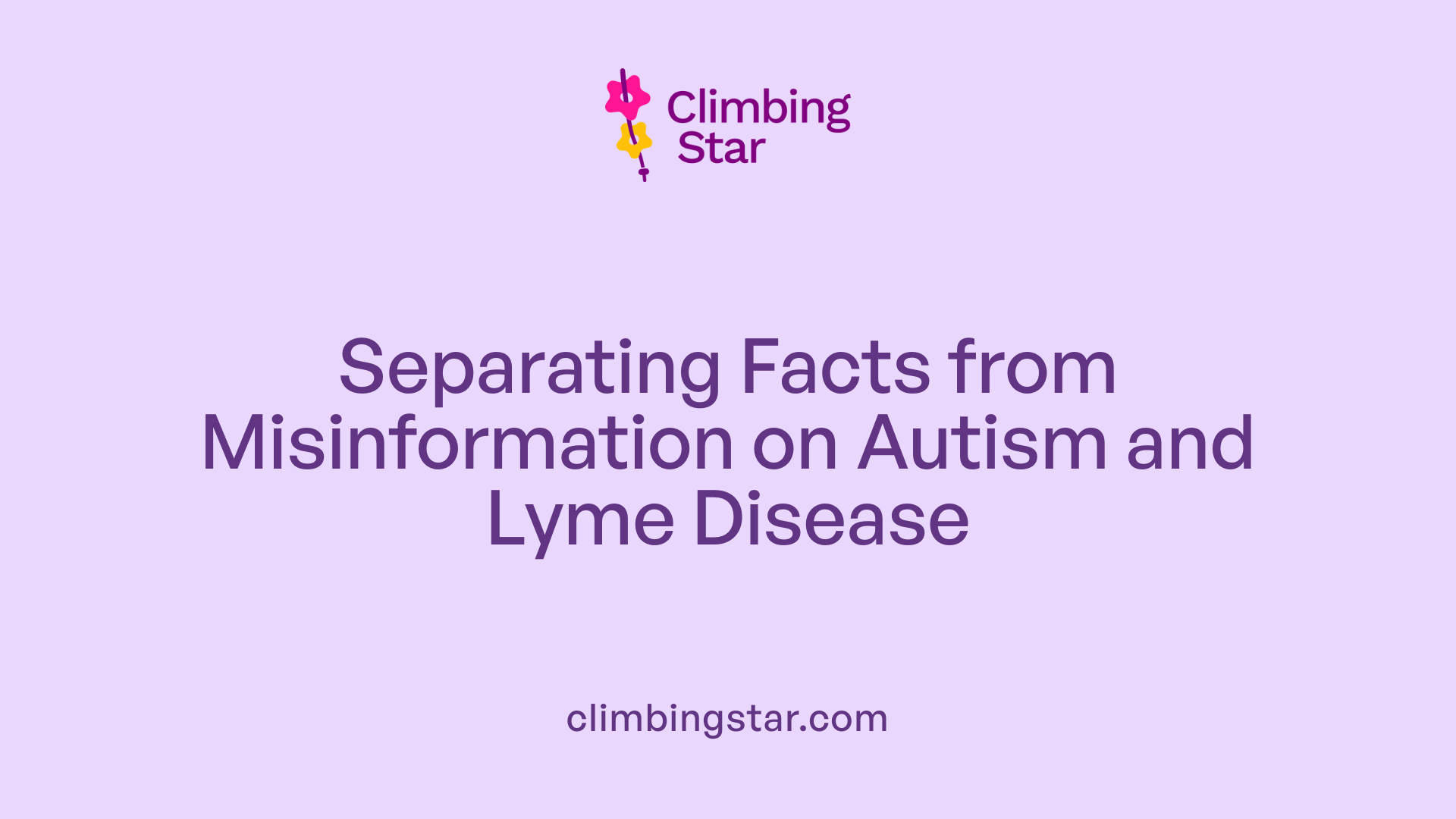Introduction to Autism and the Lyme Disease Question
Autism Spectrum Disorder (ASD) is a complex neurodevelopmental condition characterized by challenges in social interaction, communication, and repetitive behaviors. In recent years, some have questioned whether infections like Lyme disease might trigger or contribute to autism. This article explores the relationship between Lyme disease and autism, while shedding light on a well-established therapeutic approach known as Applied Behavior Analysis (ABA) therapy that supports individuals with autism in developing essential skills and improving their quality of life.
Dissecting the Link: Can Lyme Disease Cause Autism?

What is Lyme Disease?
Lyme disease is an infection caused by the bacterium Borrelia burgdorferi, transmitted to humans through the bite of infected black-legged ticks. Common symptoms include fever, headache, fatigue, and a characteristic skin rash. When untreated, the infection can affect the joints, heart, and nervous system, sometimes leading to neurological complications.
Current Understanding of Autism Causes
Autism spectrum disorder (ASD) is a complex neurodevelopmental condition primarily influenced by genetic factors and early brain development. Researchers acknowledge that a combination of hereditary and environmental factors contribute to the risk of autism, but infections acquired after birth have not been established as direct causes.
Is There Evidence That Lyme Disease Causes Autism?
At present, scientific research does not support a direct causal connection between Lyme disease and autism. Although Lyme disease can produce neurological symptoms in some cases, these do not match the defining features of autism spectrum disorder. The neurological impacts of Lyme disease are typically acute or chronic inflammation and nerve damage rather than the developmental differences seen in ASD.
Research on Lyme Disease and Autism
Investigations into links between infections like Lyme disease and autism remain limited. Studies have not found consistent evidence to suggest that Lyme disease influences neurodevelopment in a way that would cause autism. Ongoing research continues to explore various environmental factors, but Lyme disease has not been identified as a factor influencing autism onset.
This understanding underscores the importance of differentiating between neurological symptoms caused by infections and neurodevelopmental conditions rooted in early brain development.
Understanding Autism Spectrum Disorder (ASD)

What is autism and what are its main characteristics?
Autism Spectrum Disorder (ASD) is a neurodevelopmental condition characterized by challenges in social communication, as well as restricted and repetitive behaviors. These symptoms typically appear in early childhood but differ greatly in severity and presentation among individuals. ASD impacts how people perceive and interact with the world around them.
Neurodevelopmental factors
ASD arises primarily due to genetic influences that affect brain development and neural connectivity. These neurodevelopmental differences shape the unique ways individuals with autism process information, communicate, and respond to their environment.
Common misconceptions about causes
Despite persistent myths, vaccines do not cause autism. Scientific research confirms that genetic factors and early brain development play the most significant roles. Misunderstandings about the origins of ASD can contribute to stigma and misinformation, highlighting the need for accurate education and awareness.
Applied Behavior Analysis (ABA) Therapy: A Cornerstone for Autism Support
What is applied behavior analysis (ABA) therapy and how does it help individuals with autism?
Applied Behavior Analysis (ABA) therapy is a treatment method grounded in behavioral science, designed to support individuals with autism spectrum disorder (ASD). It focuses on enhancing critical skills such as communication and social interaction while aiming to decrease behaviors that may interfere with learning or daily functioning. ABA achieves these goals through reinforcement techniques and careful observation, creating customized plans tailored to each person's unique needs.
Definition and purpose of ABA therapy
ABA therapy systematically applies behavioral principles to encourage positive behaviors and diminish challenges. Its purpose is to promote intellectual development and improve adaptability, particularly for children with autism. The therapy emphasizes measurable outcomes and continuous progress tracking, which helps refine intervention strategies over time.
Historical background
The roots of ABA therapy trace back to the mid-20th century, when researchers began studying how behavior can be influenced by environmental factors. Its methods emerged from early behaviorist theories and have since evolved considerably. Over decades, ABA became recognized as an effective, evidence-based approach for assisting individuals with autism.
Scientific validation
Numerous studies have confirmed the effectiveness of ABA therapy. Research shows that intensive early intervention using ABA can lead to significant improvements in communication, social skills, and overall functioning. These findings have established ABA as the most widely endorsed behavioral treatment for autism by professional organizations worldwide.
Who Are the Providers of ABA Therapy? Qualifications and Roles
Who provides ABA therapy and what qualifications do they typically have?
ABA therapy is primarily provided by licensed professionals such as Board Certified Behavior Analysts (BCBAs), psychologists, and certified behavior analysts. These practitioners usually hold advanced degrees in psychology or related fields, underpinned by comprehensive academic training.
Professional backgrounds of ABA therapists
Most ABA therapists come from psychology or related behavioral science backgrounds. They undergo a significant amount of education, including bachelor's, master's, or doctoral degrees, before entering clinical practice. This foundational knowledge prepares them to understand complex behavioral issues and apply ABA principles effectively.
Certification requirements
To become a BCBA, candidates must complete 1,500 to 2,000 hours of supervised clinical experience, pass a certification exam, and adhere to continuing education guidelines. This rigorous certification process ensures that therapists are competent in both theoretical understanding and practical application of behavior analysis.
Skills and training involved
Beyond academic qualifications, ABA therapists develop skills such as acute observation, critical analysis, and empathetic communication. Their training emphasizes customizing intervention plans to meet individual client needs, requiring both technical expertise and interpersonal sensitivity.
These qualification standards and professional roles help ensure that ABA therapy is delivered safely and effectively, guiding individuals toward meaningful behavioral improvement.
Key Techniques in ABA Therapy for Autism
What are the main techniques used in ABA therapy?
ABA therapy employs a variety of methods designed to enhance learning and social skills in individuals with autism. These techniques are tailored to meet individual needs and often integrated for comprehensive treatment.
Discrete Trial Training (DTT)
DTT is a structured, one-on-one teaching method that breaks skills into small, manageable steps. Each trial has clear instructions, a response opportunity, and a consequence, making it especially effective for teaching foundational skills.
Natural Environment Training (NET)
NET focuses on teaching skills during everyday activities and interactions. This approach makes learning more meaningful by using natural settings and the child's interests to promote generalization of skills.
Pivotal Response Treatment (PRT)
PRT is a play-based technique that emphasizes motivation, self-management, and social initiations. It targets pivotal areas of a child’s development, aiming to produce broad improvements across communication, behavior, and social skills.
Verbal Behavior Interventions
These interventions specifically aim to develop language skills by teaching communication functions like requesting, labeling, and conversational skills, utilizing the principles of ABA focused on verbal behavior.
Reinforcement strategies
Positive reinforcement is central across all ABA techniques. It involves rewarding desired behaviors to increase their frequency and using consistent feedback to reduce negative behaviors.
These approaches together create a flexible toolkit for therapists to maximize developmental gains and improve quality of life for individuals with autism.
Tracking Progress: How is ABA Therapy Effectiveness Measured?
How is progress measured during ABA therapy?
Progress in ABA therapy is tracked through systematic data collection methods tailored to monitor specific skills and behaviors. Therapists commonly use frequency counts to record how often a targeted behavior occurs, and duration recording to measure how long a behavior lasts each time it appears.
Data collection methods in ABA
Consistent data recording ensures precise monitoring of changes over time. Frequency and duration are primary quantitative measures, while qualitative observations help understand the context and quality of behaviors.
Assessment tools
Standardized assessments complement direct observation by providing structured measures of skill acquisition and behavioral changes. These tools help establish baselines and track ongoing progress in a reliable manner.
Adjusting treatment plans
Collected data is regularly reviewed to assess if the current treatment approach achieves desired outcomes. If progress plateaus or declines, therapists modify the individualized treatment plan by introducing new strategies or focusing on different goals to improve therapy effectiveness.
| Aspect | Method | Purpose |
|---|---|---|
| Data Collection | Frequency counts, duration | Quantify targeted behaviors |
| Assessment Tools | Standardized evaluations | Track skill acquisition and behavioral changes |
| Plan Adjustment | Review data, modify goals | Optimize therapy outcomes |
Critically Evaluating ABA Therapy: Challenges and Controversies

What are the potential challenges or criticisms of ABA therapy?
Applied Behavior Analysis (ABA) therapy, while widely used, has faced notable critiques over time. Historically, some ABA methods included aversive techniques, such as unpleasant stimuli, which are now regarded as unethical and have been largely abandoned. This past use has contributed to ongoing concerns about the approach.
Another criticism centers on the rigidity of ABA therapy. The focus on encouraging compliance and reducing certain behaviors may inadvertently cause emotional distress. Critics argue that this can suppress individuality and may not fully respect the unique personalities of those undergoing treatment.
Additionally, there is growing dialogue around neurodiversity—a perspective that values neurological differences as natural variations rather than disorders to be corrected. Some advocates call for ABA therapies to evolve, emphasizing respect for autistic identity and prioritizing emotional well-being and personal autonomy rather than merely modifying behaviors.
These challenges highlight the importance of ethical considerations and adapting ABA practices to be more person-centered and supportive of diverse experiences.
Integrating Autism Therapy and the Lyme Disease Discussion

Why understanding therapy matters amid disease hypotheses
Autism therapy focuses on improving communication, behavior, and social skills through evidence-based interventions. When unproven disease theories, such as linking autism directly to Lyme disease, are introduced, they can distract families from therapies that have demonstrated effectiveness. Understanding and committing to established therapy approaches supports consistent progress and avoids unnecessary treatment detours.
Importance of evidence-based interventions
Effective autism therapies, like Applied Behavior Analysis (ABA), speech therapy, and occupational therapy, rely on solid scientific evidence. These methods have been continually refined and validated to support developmental gains. Pursuing interventions based on rigorous research results in better outcomes compared to those grounded in assumptions or unsupported disease hypotheses.
Avoiding misinformation impacts
Misinformation around Lyme disease as a cause of autism risks misguiding caregivers and clinicians. It can lead to delays in proper therapy, increased stress for families, and financial burdens from unproven and potentially harmful treatments. Staying informed through credible sources helps maintain focus on therapies that truly enhance the quality of life for individuals with autism.
The Role of Families and Caregivers in ABA Therapy
Family involvement in therapy
Families play a vital role in Applied Behavior Analysis (ABA) therapy. Their active participation helps reinforce learning and behavior changes outside the clinical environment. By engaging in therapy sessions and practicing techniques at home, caregivers provide consistency, which enhances the overall effectiveness of ABA interventions.
Supporting individualized needs
Each individual undergoing ABA therapy has unique strengths and challenges. Families and caregivers help tailor approaches to fit these individual needs by sharing insights about the person's preferences, routines, and behavioral triggers. This personalized support ensures that therapy strategies remain relevant and effective.
Collaboration with professionals
Successful ABA therapy depends on strong collaboration among families, therapists, and other professionals. Open communication allows for monitoring progress and adjusting goals as needed. Families provide valuable feedback and help generalize skills learned in therapy to real-world settings, fostering greater independence and improved quality of life.
Future Directions: Autism Research and Therapy Developments

Ongoing autism research
Autism research continues to advance rapidly, focusing on understanding its complex genetic and environmental causes. Scientists are exploring brain development patterns and neural connectivity to better comprehend the underlying mechanisms of autism spectrum disorder (ASD). This research aims to facilitate earlier and more accurate diagnoses.
Innovations in behavioral therapies
New behavioral therapies are emerging that leverage technology, such as virtual reality and mobile applications, to enhance social skills and communication. These therapies are designed to be more engaging and adaptable to individual needs, offering interactive and real-time feedback to support learning and development.
Emphasis on personalized, ethical care
There is a growing emphasis on tailoring interventions to the unique profiles of individuals with autism. Personalized care plans consider sensory sensitivities, strengths, and preferences to improve quality of life. Additionally, ethical considerations are paramount, ensuring respect for autonomy and promoting dignity in all therapeutic approaches.
Understanding Autism Beyond Infection Myths
While hypotheses linking Lyme disease to autism exist, they lack scientific support. Autism remains primarily a neurodevelopmental condition best addressed through evidence-based therapies like ABA, which empower individuals with autism to thrive. Recognizing the qualifications of therapy providers, employing effective techniques, monitoring progress carefully, and respecting individual differences are vital components of successful autism support. Embracing ongoing research and ethical considerations ensures that treatment continues to evolve in ways that honor neurodiversity and improve lives.







